|
Simple Bike Regulator |
Dynohub Regulator |
Bike Regulator Links |
Dynamo Lighting Links |
Bike Radios |
Electronics Links |
Bicycle Radios
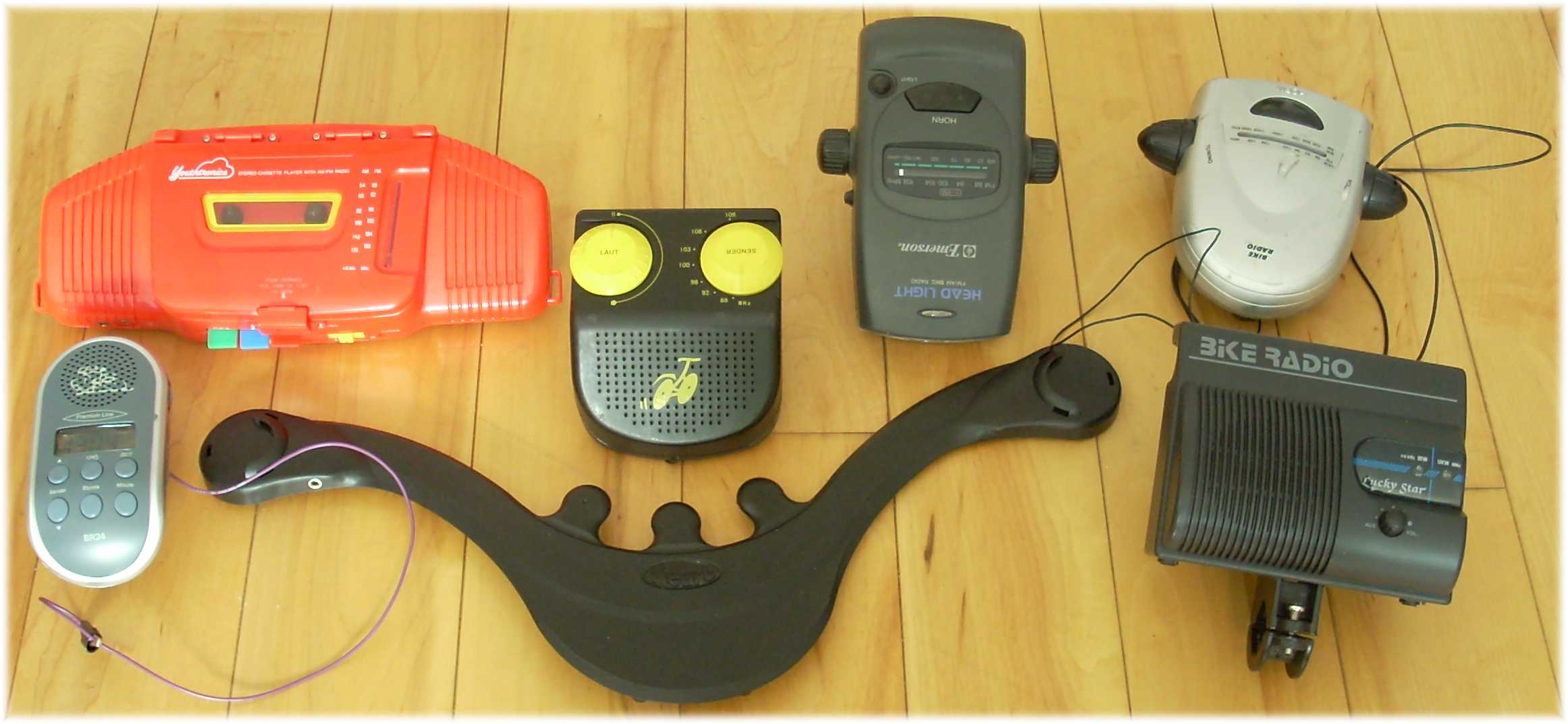
|
Simple Bike Regulator |
Dynohub Regulator |
Bike Regulator Links |
Dynamo Lighting Links |
Bike Radios |
Electronics Links |
Bicycle Radios

Note: The brand name under which a particular model is sold varies from country to country. Further, the same model may be sold in one country under different brand names. Finally, not only a different model may appear, overnight, under previous model's name, but also two different models may coexist simultaneously in one market under the same name. Most, especially poorer models, survive for about 3 years on the market.
It is not possible to escape the fact that the bike radios are generally cheap. Regarding design, a large geared tuning knob is preferred, accessible from a handlebar, as well as a speaker directed towards the face. A greater power is preferred, given that wind can interfere with the listening. Miniscule radios, as difficult to hear, should be generally avoided.. Use of more than just 2 AA batteries can indicate a higher power. An automated tuning will usually eliminate all but the strongest stations and may force an awkward juggling to get to the desired station. Crummy additions add size, weight and/or bother. Since only a small fraction of buyers are likely to use those radios over a longer time, the designs must be thwarted towards an impulse buying.
Present-day radios have usually AM and FM, but sometimes come only with FM. Old radios may have AM only. For FM reception, the radios have a wire antenna cramped inside the housing a bit away from the circuit board. The antenna may in the form of a coil, a bundle of wire or something in-between. The FM sensitivity may be improved by running a piece of insulated stranded wire to the outside of the radio and connecting it to the circuit board where the original antenna connects or to the original antenna itself. Further, with the added external antenna, the selectivity may be improved by removing the original internal antenna. This is because a cramped bundle of wire tends to pick up signals from a range of frequencies, with a stronger nearby station usually dominating the weaker stations farther away.
If you need to find out how the term bicycle radio is defined .
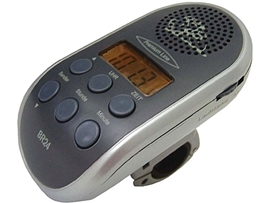
|
Fun Collection Bike Radio BR24 by ML Solution from Herten, Germany.
Finally, a radio that clearly passes over the threshold for serious products,
above the realm of toys to which most bike radios belong.
It is a pity that this radio must also have some elementary
design flaws.
BR24 has FM only. Its greatest asset is tuning. The manufacturer claims that the radio is equipped with a PLL tuner. The Phase Lock Loop (PLL) circuit uses a reference signal that is mixed with that from the antenna. Synchronization of the phase between signals allows to suppress any noise interfering with the signal from the transmitting station and to filter out the latter signal better. Among the standard radios, the PLL circuit tends to indicate better quality. This radio indeed picks up distant stations exceptionally well. Without an added external antenna, the radio picks up 24 stations in my area. With the added antenna (location for connecting marked on the radio's PC board), the radio picks up 40 stations. While this may seem similar to the Radio Shack radio reviewed separately, the reception of individual stations is significantly better than for the Radio Shack. The clarity is greater and reception is more consistent, in particular the quality of reception is maintained when the radio is moved around, unlike for the Radio Shack. Additionally, finding specific stations is facilitated by the digital tuning supplemented with a digital display. For an analog display, the correlation between the displayed and dialed frequency may be off by 2 MHz or so. In BR24, one button on top of the radio moves the frequency up by 50 kHz and another down by the same amount. Pushing either button longer activates the seek function with the frequency changing until a strong station is found. As an example of the dramatic difference between BR24 and Radio Shack, a distant station that I might comprehend 40% of time with Radio Shack is identified as a strong station by the seek function of BR24. In both cases an external wire antenna has been used. Volume in BR24 is adjusted with a rotary knob that also serves as an on-off switch. The digital display lights up for a moment whenever a pushbutton is pushed or power is toggled. The radio works off 2 AA batteries, has a clock function and is equipped with a white LED pointing forward that may be used as 'see me' illumination. The radio also has a jack for plugging in the output of an MP3 player. The radio also comes with a coiled connecting cable and a flimsy nylon pouch and velcro for attaching an MP3 player to the frame. Flaws: 4 out of 6 pushbuttons are dedicated to clock function, suggesting that the radio might have originated as some adaptation of a clock-radio. The radio mounted on handlebars sticks high up. It is impossible to operate the controls without taking a hand off the handlebars. The seek function, kicking in at an uncertain moment, is sure to distract the rider. The LCD display is one of the darkest I have seen. The loudspeaker is illogically placed within the housing - if the speaker is to be directed towards rider's face, the illumination LED is sure to shine into the sky. A sister radio by the same manufacturer, BR22, has a more logically placed speaker, on the downward slope, within the housing of the same shape as BR24. A screwdriver needs to be used in order to change batteries. Contrary to manufacturer's claim, weather protection is nearly nonexistent. Thus, water can sip to the inside without much obstacle and the coating of internal connections is cursory at best. As far as the sound is concerned, there is practically no bass. Other comments: The radio's PC board is dominated by a single chip with a multitude of terminals. There is just one wire coil and a couple of electrolytical capacitors, of which at least one seems to work with the clock. That appears to explain the marginal sound. The brand name 'Fun Collection', symbol of a slant bicycle on the radio, and the model designation 'BR' point to the continuation of the line of radios put out before by Premier of Bremen, see my other reviews. Other current models of that line are BR22 and BR20. Previous models include BR1 and BR10, as well as cassette radios BRC16 and BRC17. Quality of all other radios I tested from that line has been substandard. The company claims to have an office in the Far East. |
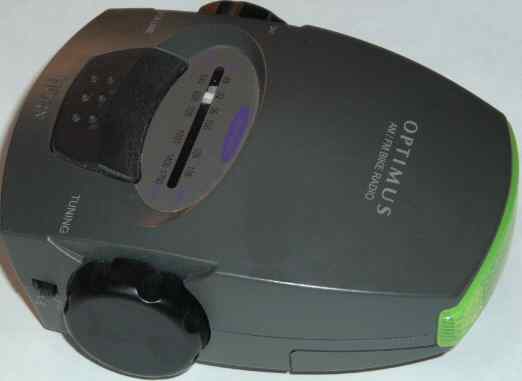
|
Optimus-Radio Shack. Comes with a redundant horn. Manufactured in China and appears to be a slightly modified, mostly stripped down, version of the Equipment Outdoor radio below. Its knobs are decent and the tuning is geared. This radio's sensitivity may be improved by connecting an outside antenna to a pin sticking out of the PC board inside or, better, an antenna terminal by the speaker. With such an antenna the radio picks up 31 FM stations in my area. Without the extra antenna, the radio picks up 25 stations. As of early '03 the radio ceased to be available in the US, but continued to be marketed in the UK and Germany. It is still abundant on German Ebay, as Elta 3122. Takes 2 AA batteries. No screwdriver is needed for changing the batteries. The plastic snap contraption locking the radio to the handlebar mount breaks after about a year of use. |
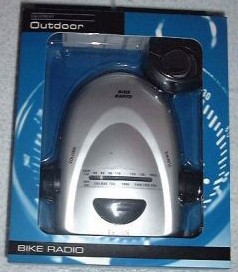
|
Equipment Outdoor Bike Radio - Elta 3122 N. A bit bulkier than the Optimus above. The larger housing improves accoustics and allows for a larger internal wire antenna. However, the radio picks up only 17 FM stations in my area, which might be due to poorer quality control. The knobs are easier to grab. The battery door opens easily, inviting the loss of both the door and batteries. In the UK it has been marketed, in particular, by the Debenhams department stores. In Germany, this radio has been marketed as AFK. Later this radio has replaced the Optimus, described above, at the German Elta. In 2009, this radio may be still found at the German Ebay. |
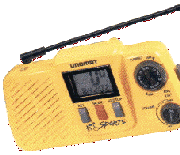
|
Unomat. Has a larger speaker than the Optimus. However, its selectivity is poorer and the housing and hardware are flimsier. It incorporates a computer with a large clear display. Made in China. Takes 4 AA batteries. No screwdriver is needed for battery replacement. |
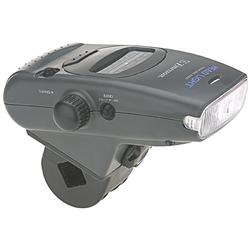
|
Emerson. Characterized by the best acoustics and best finish of the bunch. The tuning is geared. The radio has a long antenna internal antenna, but picks only 13 FM stations in my area. Taking in 3 C-size batteries, the radio is quite heavy and comes both with a crummy light and horn. The light is crummy even on the scale of mediocre lamps. A flat screwdriver is needed for battery replacement. Made in China. Has been also marketed as Pyramid and as Sunlite. |
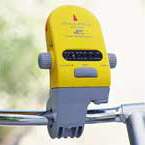
|
ATC. From Taiwan, ATC just lent the name. It takes 4 AA batteries. Has a larger speaker, higher power, geared tuning and a better internal antenna than Optimus. However, its selectivity is poorer - does not lock on distant stations. It has been marketed in Germany as Precision. |
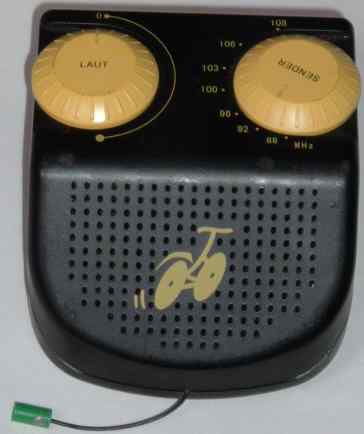
|
BR-2000. Has a decent loudspeaker directed towards the rider. It is characterized by a poor selectivity and an average sensitivity. It is the only one of the bunch equipped with a connector to an outside antenna. With the antenna, the radio picks up 17 FM stations in my area. Takes two AA batteries. A small Phillips screwdriver is required for battery replacement. Made in Germany by Premier Bremen. |
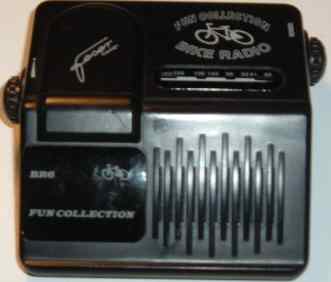
|
BR6. Another radio by the Bremen manufacturer. The loudspeaker directed towards the rider is about the only positive for this radio. The sound quickly deteriorates when increasing the loudness. The knobs are small. The selectivity is poor and sensitivity average. In my area, the radio picks up 17 FM stations. The radio takes 3 AAA batteries. You need a Phillips screwdriver to open the compartment and the use of a diagram to place the batteries right. |
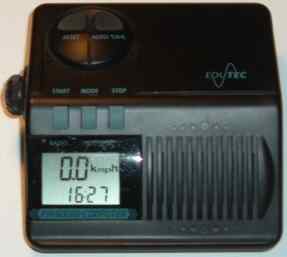
|
BCR-100. A third radio by Premier, now combined with a computer and equipped with automated tuning. The casing must have come out from a mold that was just minimally modified relative to BR6. I have not tested the computer - its positive are large digits. The automated tuning is, in practice, a disaster. While BR6 picks some 17 stations in my area, BCR-100 picks just 4! The radio takes 3 AA batteries. The production seems to have moved more recently to Asia. |
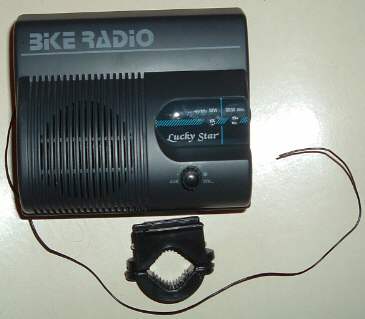
|
HFM-698/Lucky Star. Another shabby German radio distinguished by the fact that it might be used as a table radio too. Even though the radio comes with an external antenna, its sensitivity is quite unsatisfactory as it picks up only 8 stations in my area. The sound quality is about average for the bike radios. The tuning knob is sufficiently large. The radio takes 4 AA batteries. No screwdriver is required for changing the batteries. |
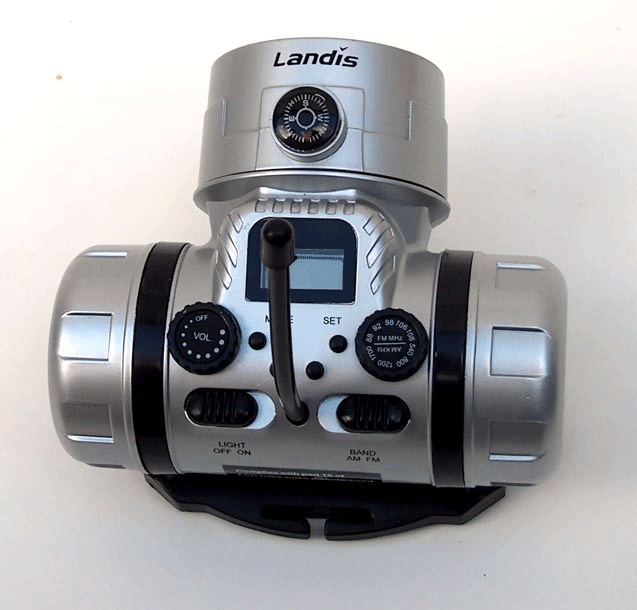
|
Landis/Pyramid. Comes with light, alarm clock & compass! The control knobs appear miniscule. Note: You might find the Emerson from above sold as a Pyramid. |

|
Sony ICF-M88B. Automated tuning (normally a negative) + a computer. 15 Station Preset. Backlit LCD. DX switch. Powered by 2 AA batteries. For reviews look here. Apparently, it is not quite loud enough and its reception is limited. |

|
Youthtronics stereo radio cassette. The benefits of stereo and cassette are difficult to disregard, but sound and sensitivity are inferior relative to few other bike radios. The radio satisfactorily picks up 12 FM stations in my area. Has an earphone jack. Volume control is difficult to grab and weatherproofing is crude. Made in China. Takes 4 AA batteries. |
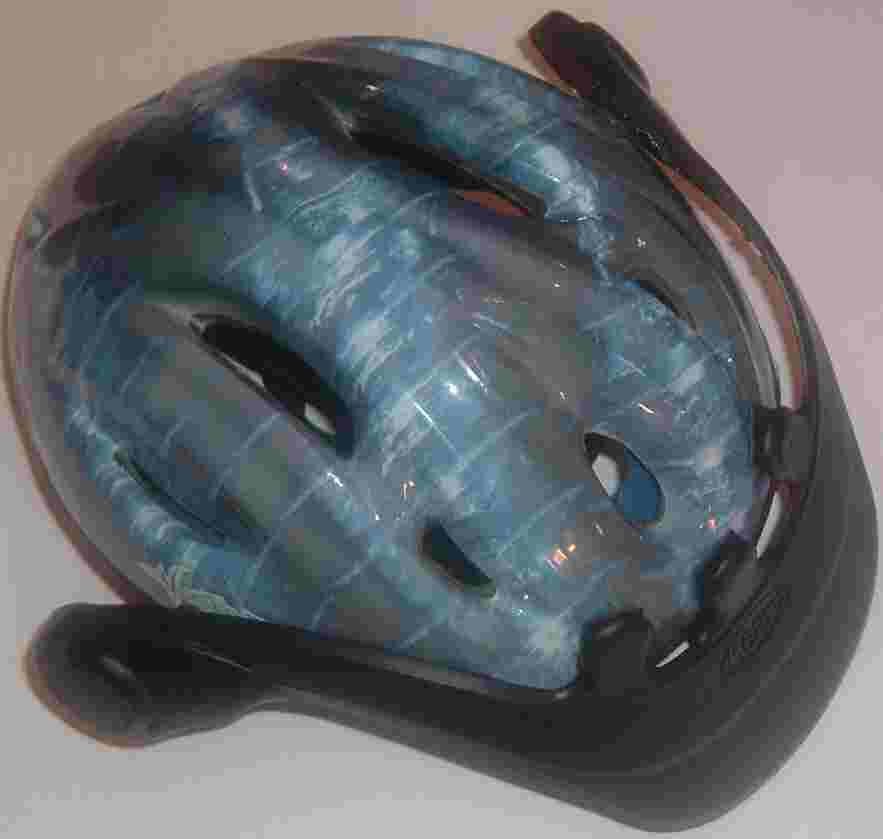
|
Bike-Hearo. An interesting radio built into a helmet visor, with speakers hanging in vicinity of the earlobes. The radio attaches with velcro patches to the helmet. FM only. Automatic tuning. A round knob at the center of the visor serves as a volume control and a power switch. Two buttons on the side serve as scan and a reset once the end of the band is reached. If you lose a station, due to poor reception, you need to reset and rescan. The radio picks 8-9 stations in my area, curiously missing the strongest station half of the time. The sound quality is OK. The radio has an input jack for an external source and provides an amplification for that jack. The radio takes two AA batteries. Changing the batteries requires detaching the radio and using a small Phillips screwdriver. Made in China. While, overall, the radio is not quite satisfactory, as most of the others, its placement and housing may be THE way to go. |
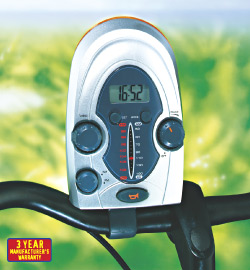
|
Welltech. An AM/FM radio with clock and horn. Sold in the Lidl supermarket chain in Europe. For Lidl, Welltech appears to be a house brand. Neil Saunders, who tested that radio, writes that it is "quite sensitive for a radio with an internal aerial ", "Outside FM is quite good" and "AM is strong inside and out". Neil further writes that the radio is manufactured by LS-Electronic. My own take is that the size and positioning of controls is such that you can forget about adjusting them while riding. The radio's overall size appears adequate. |
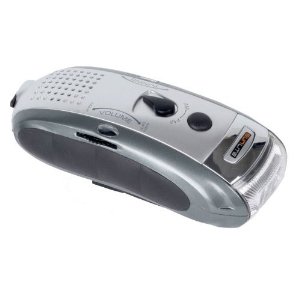
|
Sunlite Rechargeable AM/FM Radio/Light. The reviews can be found here. Careful reading of the reviews and examination of the appearance reveals that this radio is pretty much trash. |
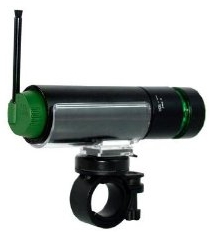
|
Lavod LFB-615c Bikeman. Truely waterproof (IP66) combination of an FM radio, MP3 player and flashlight, rechargeable through USB. |
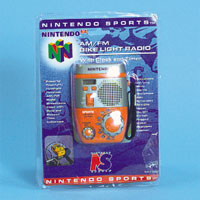
|
Nintendo |
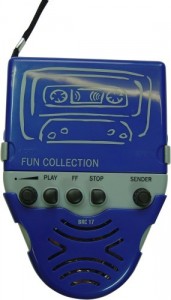
|
BRC 17. FM radio w/cassette, compass and a jack for MP3! |
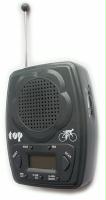
|
Radio Top/Blue Bird. (FM, digital tuning) |
– The bicycle radios are generally made weather-resistant by
using a tight housing and a speaker w/plastic diaphragm.
Water getting inside may throw off the tuning; the radio
may require a complete drying to become operational afterwards.
– Similarly to other products suitable for bicycle commuting, there
is a particular abundance of different radios in Germany.
Subject to hindrances of language, payment and shipping, that
the brave can overcome, the German Ebay can
offer a good choice of the radios.
–
From the radios I had an opportunity to test out, my ranking is
as follows, from top to bottom: BR24 (w/added antenna) > BR24 > Optimus (w/added antenna) >
Outdoor/AFK (w/added antenna)
> Optimus (no modifications)
> Outdoor/AFK (no
modifications)
> Emerson
> ATC > BR-2000
> Unomat > Bike-Hearo > BR6 > Youthtronics
>> Pyramid. This rating reflects my particular rating of various
features. I tried to indicate the advantages of each model above.
Emerson and ATC do not much benefit from an added antenna, as the
antennas they come with are already long.
WPKN - best internet radio!
danielewicz@nscl.msu.edu,
HOME
Copyright © 1998-2010 by Pawel Danielewicz. Permission is given
for a non-profit,
non-commercial use acknowledging the copyright.